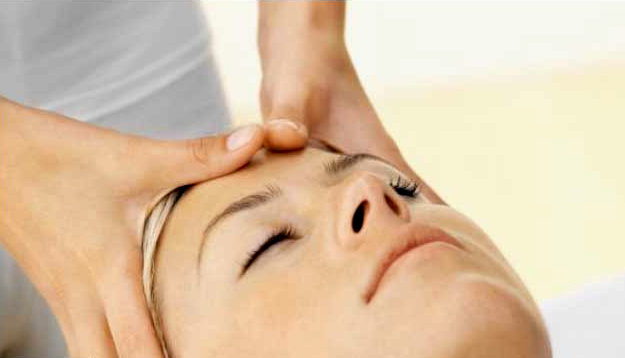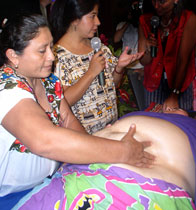I am very honored to be here at Full Circle Family Care, surrounded by a wonderful group of highly skilled Women’s Health Care professionals. This is truly a “dream come true” as since my childhood, I have always thought that I would somehow be involved with helping women through pregnancy, labor and delivery… So as a Massage Therapist, Doula and Certified Arvigo Practitioner (CAP) who has had a private practice alone since 1991, I am thrilled to have found my professional “home” and “community!”
I would like to introduce you to the Arvigo Techniques of Maya Abdominal Therapy through this wonderful article in Midwifery Today, so that you will better understand the amazing benefits of this ancient technique that is beautifully combined with modern scientific techniques as created and taught by Rosita Arvigo, Doctor of Napropathy, who studied with a Mayan medicine man, Don Elijio, in Belize for over 13 years and also with Mayan midwives. Enjoy!
by Anne Hirsch
© 2008 Midwifery Today, Inc. All rights reserved.
[Editor’s note: This article first appeared in Midwifery Today Issue 84, Winter 2008.]
Mary Kroeger, CNM, wrote an article for Midwifery Today in the 1990s about the Arvigo Techniques of Maya Abdominal/Uterine Massage (ATMAM) (Midwifery Today Issue 49, Spring 1999). She concluded that she “remained undecided on the technique,” but said, “One thing is for sure, however: If the technique does what it claims, gynecologists, surgeons and producers of synthetic female hormones may need to find other means of employment!”
I understand her indecision because I was skeptical when I first encountered this treatment, but now after one and one-half years as a practitioner of this technique, I must say that it absolutely works. It works with pregnant women and with women in all stages of the lifecycle.
In this article I will share some brief theory and many anecdotal experiences that are representative of what is reported over and over again by women receiving this treatment or practicing the self-care techniques.
We are taught in modern midwifery that the way the uterus lies in the pelvis is of little consequence. We might know that it is retroverted or anteverted, but we do nothing about it. We are told it makes little difference except in extreme cases in which a growing pregnant uterus might become trapped if it is very retroverted.
The Maya see this differently. They say that how the uterus lies in the pelvis makes all the difference. My experience with ATMAM has shown this to be correct.
As a Certified Professional Midwife (CPM) providing homebirth services, I work only with healthy women who have normal uncomplicated pregnancies. My practice is personal and wellness-oriented with a strong focus on nutrition, which helps women avoid many common discomforts associated with pregnancy.
Some women still have to put up with those pesky annoyances: aching hips, painful ligaments, a tight back, sciatic pain and pelvic pain. In the past, I have had to say, “This is just part of pregnancy.”
That is, until I learned about ATMAM. These techniques have changed the way I practice midwifery. Now I can offer relief where once I had little ability to help. Let me give you some examples.
At a recent client’s prenatal I was confronted with a somewhat agitated woman who said she had not slept well for two nights. Her back felt jumpy. Her hips hurt. She just could not get comfortable. She had even tried sleeping on a bean bag chair in a position that gave relief for a while but then the discomfort returned. “Well then,” I said, “let’s give you a Maya massage!”
She relaxed deeply during the treatment, which included the uterine massage and the sacral work that Dr. Rosita Arvigo teaches. Afterwards this woman felt a bit better and looked remarkably more relaxed. I asked her to go for a walk to allow the corrections to the hips to settle in.
The next week she reported that all discomfort had gone. She was sleeping well and back in bed with her husband. The discomfort never returned and she was able to enjoy the final weeks of her pregnancy until she gave birth. I was astounded and very happy I’d been able to help her!
Another one of my clients, a woman at 26 weeks gestation, complained that her uterus was very uncomfortable. Before she was pregnant she had been in an automobile accident in which the car she was riding had flipped three times. Clearly her uterus had flopped around and the ligaments were strained. I used the Arvigo techniques to measure between the hips and the uterus. I found her uterus markedly leaning toward her right.
We began a very gentle uterine massage. I worked on her uterus for about 8–10 minutes. By the end of this session, much to my surprise, the uterus was visibly more centralized. When she got up she felt comfortable and remarked on this. Her uterus remained centralized throughout the remainder of her pregnancy.
I also have been able to relieve sciatic pain and pelvic pain in my pregnant clients. Sometimes it resolves completely. At other times ongoing tune-ups keep it at bay. This is a real boon for a midwife. Women are so grateful for this help. One client even called me a half hour after our visit to say “You are my hero. I’m pain free!”
A third woman of twenty-two years was pregnant with her first baby. Her mother had had c-sections because her pelvis was very narrow. At term, forty weeks, this primipara’s baby was above the pubic bone. I gave her a treatment and within one and one-half days the baby dropped into the pelvis.
After a second treatment she went into labor—a long prodromal labor with a baby in persistent left occiput transverse—and then during active labor, in persistent posterior position. I treated her with the Maya techniques throughout. The baby had a very tight squeeze and heart tones dipped way down with pushing. Artificial rupture of the membranes revealed moderate meconium. We had to transfer her to the hospital where the heart tones were in the 80–90s throughout pushing, but she gave birth vaginally to a 6 lb 14 oz baby girl with 9/9 Apgar scores. This was a real triumph and I believe the Maya massage technique helped make it possible.
Midwives using this technique report that women who have treatments during the last three weeks of pregnancy tend to go into labor very near their due date. That is because specific external maneuvers, applied from thirty-eight weeks gestation on, serve to stimulate the cervix.
This treatment also has profound benefits for non-pregnant women.
One of my daughter’s friends who had just graduated from college was having such bad pain with menstruation that she was missing a day or two of work every month. She came for a treatment and I taught her the self-care techniques. After one treatment and a month of daily self-care her pain was gone!
I spoke with another woman who had received this treatment after suffering through years of pain with intercourse. The doctors had told her that nothing could be done. After a series of treatments she no longer had pain with intercourse. Imagine her delight!
As a perimenopausal woman, I was experiencing weakening bladder control. Once I started doing this technique as self-care for a consistent three-month period, that problem resolved. Now if I feel it creeping back I begin daily self-care and it resolves again. I was also beginning to develop a varicosity in my left calf. After my first three treatments, it got a lot better and has progressed no further.
This work empowers women. The treatments can assist in healing long-standing or short-term female issues. The self-care gives women a tool with which they can maintain their own female health.
At the six-week postpartum visit with my clients, I now have something much more profound to offer them than “Do your Kegels for the rest of your life!” A full Maya Abdominal/Uterine Massage treatment, with instruction in self-care, allows my client and me one last personal interaction. I can send her off with one more piece of knowledge to use to maintain her health.
This technique also allows a midwife to practice an alternative form of gynecological care. This does not replace medical care, but provides tools to heal the symptoms that a gynecologist may have no tools to relieve, except for medication or surgery.
I believe that all midwives will want to be trained in this modality. In fact, I foresee a time when it will be a mandatory part of the curriculum for any midwife because the healing possibilities of this ancient tool for female wellness are simply profound.
Until then, to learn more about this work and find a training schedule, go to www.arvigomassage.com.
Anne Hirsch is the mother of one daughter. She practices homebirth midwifery in St. Petersburg, Florida, and the surrounding area. She is certified in the Arvigo Techniques of Maya Abdominal/Uterine Massage, with a specialty in pregnancy work.





